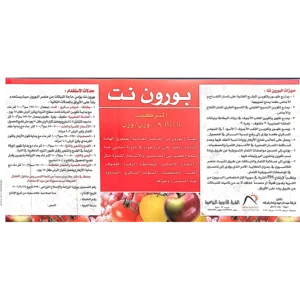Info
1- Boron Net liquid fertilizer prevents the appearance and formation of cork spots on apple and pear fruits, as well as preventing their distortion.
2- It prevents the formation of cork tissue in the soft tissue of apple and pear fruits.
3- Boron Net liquid fertilizer prevents the emergence and formation of the hollow core in potato tubers and cruciferous plants (cabbage- Zahra)
4- It prevents the appearance and formation of the hollow heart (black) in sugar beets, and it also leads to an increase in the sugar level in the crop.
5- Boron Net liquid fertilizer works to harmonize the opening of flowers, increase the percentage of knots in them, and prevent small fruits from falling in fruit trees and citrus fruits.
6- It leads to an improvement in the marketing characteristics of fruits by increasing the rates of formation and storage of proteins in them.
7- Boron Net liquid fertilizer leads to hardening of fruits and plants by fixing the calcium element in the cell walls, which leads to an improvement in the marketing characteristics of fruits.
Due to the high soil pH in Syria, the absorption of boron from the soil is little or non-existent, so it must be provided to plants by spraying it on the leaves.
Group
fertilizer
Usage rate
Boron Net liquid fertilizer give the plants' need from the element boron, as it is used as a spray on the leaves at the following rates:
1- Potatoes, sugar beets, turnips: at a rate of 100-125 cm3/100 liters of water with the beginning of the formation of tubers under the surface of the soil, and the spraying is repeated every 15 days.
2- Cruciferous family (cabbage, flower, cabbage): at a rate of 150-175 cm3/100 liters of water after transplanting 3-4 weeks, and it is preferable to repeat spraying every 20 days until the crop matures.
3- Fruitful trees and grapes: 200-250 cm3/100 liters of water at The beginning of the fruit set, the spraying is repeated 3-4 times.
4- Citrus: 225-250 cm3/100 liters of water with the beginning of the flowers coloring in crimson color. The spraying is repeated 4-6 times.
5- Wheat, barley, and corn: 50-100 cm3/100 liters Water together at the beginning of the appearance of the fourth leaf in wheat and barley and before the appearance of the male inflorescence in corn.
6- Onions and garlic: 50-100 cm3/100 liters of water two months after planting and 4-5 weeks before crop maturity and uprooting.
7- Protected crops And different vegetables: 100-150 cm3/100 liters of water at the beginning of flowering, and it is preferable to repeat the spraying every 15 days.
Application and Uses
Boron is one of the important micronutrients for plants, which means that its presence in the soil is very essential for the success of many crops and fruit trees such as (apples, pears, potatoes, flowers, cabbage, grapes, citrus, sugar beet, tomato, sunflower) and others.
Boron Net liquid fertilizer
Useful Links
en.wikipedia.org/wiki/Boron [^]
Composition:
Each 100ml contains:| B2O3 | 9 | %w/w |
Useful info
Boost Your Crop's Health with Boron Net liquid fertilizer
Welcome to our blog, where we share valuable insights on how to improve your crop's health and maximize your yields. In today's post, we're excited to discuss the benefits of Boron Net liquid fertilizer and how it can revolutionize your farming practices. Whether you grow apples, pears, potatoes, or any other crops, Boron Net liquid fertilizer is a game-changer that you don't want to miss!
The Power of Boron Net liquid fertilizer
When it comes to providing essential nutrients for your crops, boron plays a crucial role. As a micronutrient, boron is needed in small quantities, but its impact on plant growth and development is significant. By using Boron Net liquid fertilizer, you can ensure that your crops receive the optimal amount of this essential nutrient.
Boron is essential for various physiological processes in plants, including cell wall formation, flower development, pollen germination, and fruit set. It aids in the transportation of sugars and other nutrients, enhances nitrogen metabolism, and improves overall plant health. In short, boron is like a superhero for your crops, ensuring they have everything they need to thrive and produce abundant yields.
Benefits of Boron Net liquid fertilizer
1. Increased Yield: Boron Net liquid fertilizer boosts crop productivity by improving flower and fruit development. This leads to higher yields and greater profits for farmers.
2. Enhanced Nutrient Availability: Boron helps plants absorb and utilize other crucial nutrients more efficiently, such as nitrogen and calcium. This results in better nutrient availability and utilization, leading to healthier and more robust crops.
3. Disease Resistance: Studies have shown that boron enhances a plant's natural defense mechanisms, making it more resistant to various diseases and pests. By incorporating Boron Net liquid fertilizer into your farming practices, you can reduce the need for chemical interventions and promote a healthier environment.
4. Improved Fruit Quality: Boron plays a vital role in the development and maturation of fruit. By using Boron Net liquid fertilizer, you can improve the color, size, flavor, and overall quality of your harvest, making it more appealing to consumers.
Conclusion
Boron Net liquid fertilizer is a powerful tool that can transform your farming practices and take your crop's health to new heights. By incorporating this micronutrient into your fertilizer program, you can increase yields, enhance nutrient availability, boost disease resistance, and improve fruit quality. Give your crops the superhero treatment they deserve and experience the remarkable benefits of Boron Net liquid fertilizer today!

